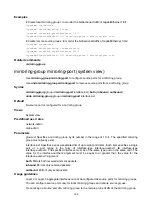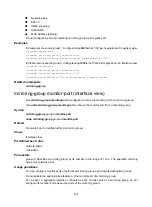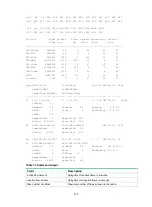
309
Use a monitor port only for port mirroring, so the data monitoring device receives and analyzes only
the mirrored traffic.
Do not configure a port of an existing mirroring group as a monitor port.
Examples
# Create local mirroring group 1 and configure GigabitEthernet 1/0/1 as its monitor port.
<Sysname> system-view
[Sysname] mirroring-group 1 local
[Sysname] interface gigabitethernet 1/0/1
[Sysname-GigabitEthernet1/0/1] mirroring-group 1 monitor-port
# Create remote destination group 2 and configure GigabitEthernet 1/0/2 as its monitor port.
<Sysname> system-view
[Sysname] mirroring-group 2 remote-destination
[Sysname] interface gigabitethernet 1/0/2
[Sysname-GigabitEthernet1/0/2] mirroring-group 2 monitor-port
Related commands
mirroring-group
mirroring-group monitor-port (system view)
Use
mirroring-group
monitor-port
to configure a port as the monitor port for a mirroring group.
Use
undo mirroring-group monitor-port
to remove the monitor port from a mirroring group.
Syntax
mirroring-group
group-id
monitor-port
interface-type interface-number
undo mirroring-group
group-id
monitor-port
interface-type interface-number
Default
No monitor port is configured for a mirroring group.
Views
System view
Predefined user roles
network-admin
mdc-admin
Parameters
group-id
: Specifies a mirroring group by its number in the range of 1 to 4. The specified mirroring
group must already exist.
interface-type interface-number
: Specifies a port by its type and number.
Usage guidelines
You can configure monitor ports only for local mirroring groups and remote destination groups.
Do not enable the spanning tree feature on the monitor port of a mirroring group.
For a Layer 2 aggregate interface configured as the monitor port of a mirroring group, do not
configure its member ports as source ports of the mirroring group.
Use a monitor port only for port mirroring, so the data monitoring device receives only the mirrored
traffic.
















































